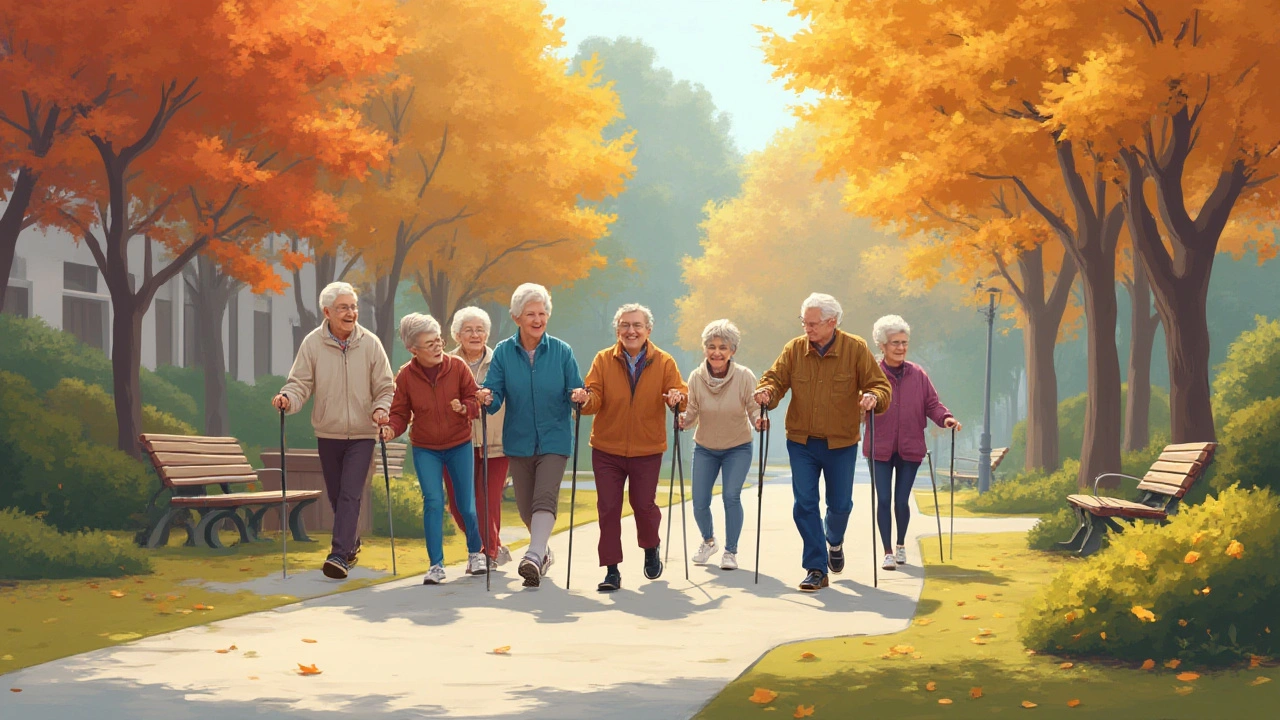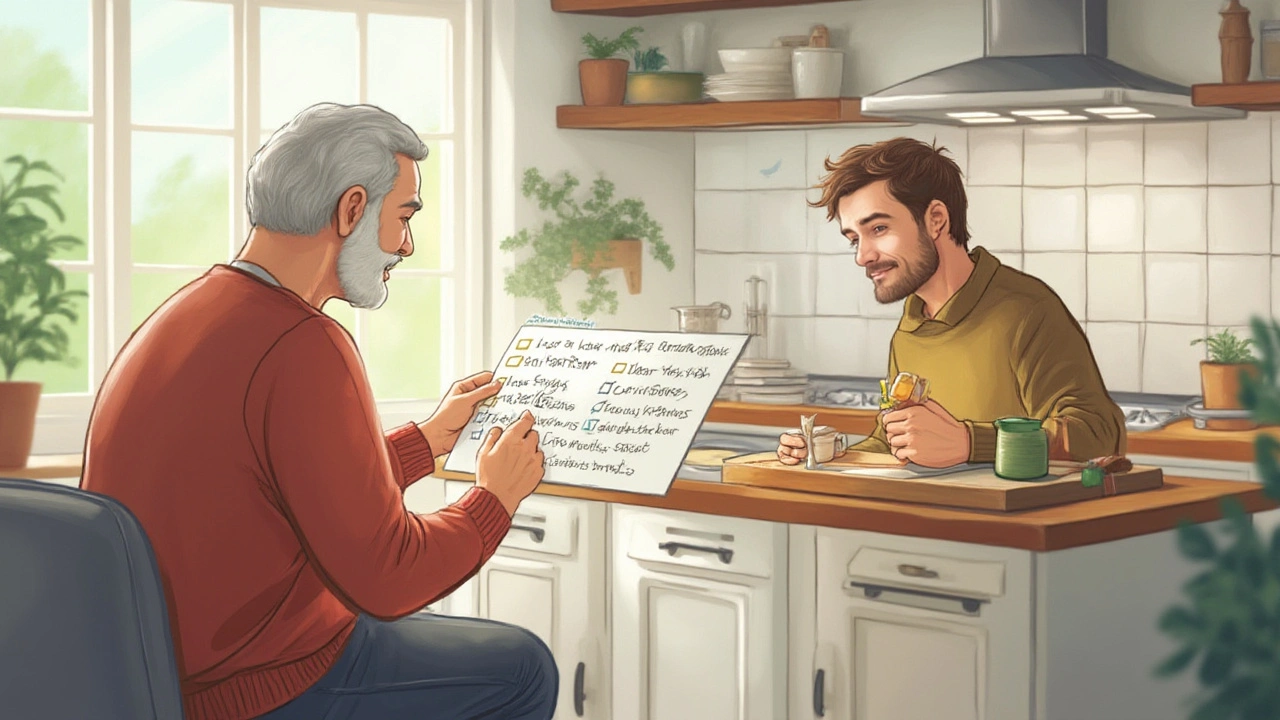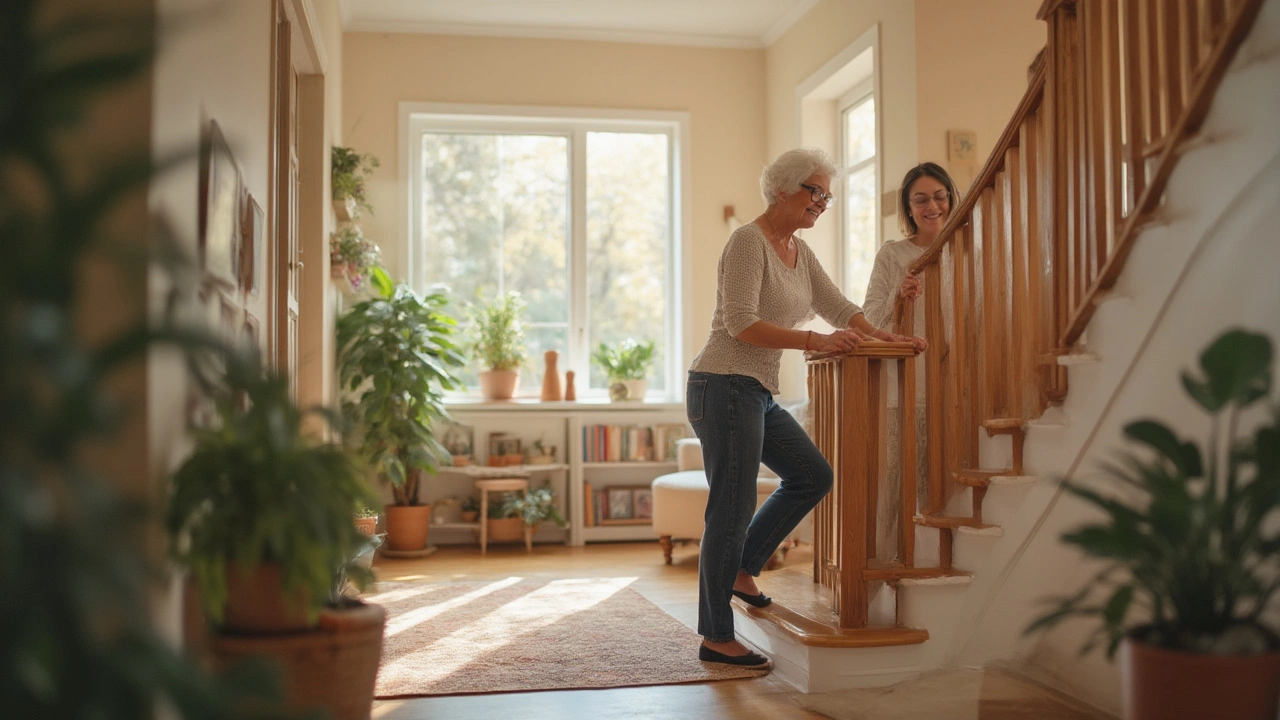Who knew a simple misstep on the carpet or catching your foot on a garden hose could change everything? It’s the kind of thing most folks brush off when they're young—maybe just a twist, a hop, and you’re fine. But for older adults, something as innocent as shuffling to the kitchen in slippers can turn risky. Sprains bring not only pain but also weeks of lost confidence and freedom. It’s wild how many people don’t realize that so much of this hassle can be avoided. And it isn’t just bad luck or clumsiness. Certain changes that come with aging make everyone more likely to get sprains, and it's not just about ankles—wrists, knees, and even thumbs are affected. If you look at NHS stats from 2024, almost 40% of emergency admissions for folks over 65 involve falls, and sprains rank high among those injuries. The silver lining? You can cut that risk way down with a sprinkle of attention and the right moves.
Why Are Seniors More Prone to Sprains?
The body has a funny way of showing its age, even if the mind stays young. Muscles shrink, reaction times slow down, and joints turn stubbornly stiff. Walking in the park or playing with grandkids becomes a balancing act. There’s a real shift in how the body responds to sudden slips. Ligaments, which are those ropey bands that keep our joints together, lose elasticity and strength over time, so they don’t bounce back as easily after a twist. Add in medications that make folks dizzy or conditions like diabetes that dull sensation in the feet, and it’s no wonder sprains are such frequent uninvited guests.
Doctors at Leeds Teaching Hospitals saw an uptick in sprain-related A&E visits over the past year. It’s not rare for Mr. Harris down the street to step off a curb and twist his ankle while collecting the post. Or for Mrs. Thompson to stretch for a teacup and catch her wrist on the edge of the table. Something as common as wet autumn leaves or slippery bathroom tiles can quickly turn dangerous.
But here’s the hopeful bit: Just a few tweaks to daily habits and some clever planning can make a dramatic difference. Experts say about 20% of all sprains in older adults are directly related to poorly-lit hallways or loose rugs. Small stuff, right? Yet it makes a world of difference. Never underestimate the power of good slippers with grip or the magic of a grab rail in just the right spot.
Common Causes and Risk Factors for Sprains in the Elderly
Every sprain has a story. Sometimes it’s a half-forgotten charger cord stretching across the living room. Other times, it’s reaching too far for the TV remote. People often assume sprains only happen during exercise, but the reality is that day-to-day living brings just as many hazards. Houses designed for young families don’t always age well alongside their owners. Changes in vision—maybe the numbers on the calendar look blurrier than they used to—can mean missed steps. Some prescription drugs prescribed for blood pressure or sleep can mess with balance, making a quick stretch or sudden movement risky.
A 2023 study from the University of Manchester found that those with osteoarthritis were significantly more likely to get wrist sprains just from simple everyday activities—lifting shopping bags, gardening, even brushing the dog. It's not only the bones and joints to watch out for; dehydration or missing meals can cause lightheadedness, which means that getting up too fast from the sofa could send someone tumbling. Even footwear deserves some blame—people keeping their favorite backless slippers for decades, while the treads have long since worn away, is a classic risk recipe.
Then there’s the sneaky problem of not wanting to ask for help. Folks pride themselves on their independence, sometimes to their own detriment. But bravely lugging the laundry basket up slippery stairs or insisting on that one extra walk with the dog can come back to bite—literally and figuratively. These are ordinary stories in my neighborhood, and I see more than a few plaster casts and slings every time I’m out for groceries.

Preventing Sprains: Practical Tips for Safer Living
It’s surprisingly easy to make your home and daily life safer once you know what to look for. The first rule? Clear the floor. Shoes, bags, open drawers, and sneaky electrical cords are the silent enemies of steady feet. Even a simple nightlight in the hall makes midnight trips to the loo ten times safer. I always nudge friends to invest in a rubber bath mat and swap loose runners in the hallway for ones with non-slip backing. You wouldn’t believe the peace of mind these small upgrades bring. According to Age UK, over 60% of home sprains could have been stopped with basic home fixes.
Let’s talk about shoes. Trainers or loafers with decent grip work wonders. No more saggy, backless slippers! If mobility is an issue, grab rails and sturdy handrails on the stairs are gold. In the kitchen, keep things you use often within easy reach, not hiding above your head or tucked away under heavy boxes. If bit worried about balance, a walking stick or a frame isn’t a sign of weakness—think of it like a seatbelt; you hope you won’t need it, but boy is it a relief when you do.
Staying fit is more fun than people expect. Just 15 minutes a day of stretching, combined with simple balance exercises—like standing on one foot while brushing your teeth—can make a real difference. Check local community classes—many offer gentle yoga or Pilates especially for seniors, and many are free or donation-based. Hydration and nutrition matter more than you’d think. Keep a water bottle handy and don’t skip meals. Blood sugar dips can make you dizzy, which is a recipe for wobbles and twists.
| Preventive Measure | Estimated Reduction in Sprain Risk |
|---|---|
| Non-slip footwear | 30% |
| Home hazard removal | 25% |
| Balance exercises | 18% |
| Grab rails and aids | 15% |
| Proper lighting | 12% |
Don’t forget, it’s as much about routine as it is about big changes. Get others involved. Have a friend check your home for danger zones, or ask your GP for advice. Technology helps too—smart home alarms and fall detectors are more affordable now than ever, and local councils often give advice for free.
Quick Steps for Managing a Sprain at Home
If fate does deal a bad hand and a sprain sneaks in, there’s no need to panic. Acting fast can make healing easier. First, stop what you’re doing—don’t try to “walk it off.” The best advice is still the classic RICE method—Rest, Ice, Compression, Elevation. Grab a bag of frozen peas, wrap it in a tea towel, and hold against the swollen spot for 15 to 20 minutes every couple of hours. Light wrapping with a support bandage keeps swelling down but don’t tie it so tightly it feels numb. Most of all, take it easy. For ankles or knees, lift the leg on a cushion when sitting, and wriggle your toes now and then to keep circulation going.
Painkillers like paracetamol or ibuprofen are usually fine, but always check they’re safe with your other medications. If you see heavy bruising, wonky shapes, or can’t move the area, call NHS 111 or see a doctor. Sprains shouldn’t stop you from moving altogether; gentle movement actually speeds up healing. If you’re able, start slow range-of-motion exercises after a day or two. A lot of people feel pressure to get back to business as usual too soon. Patience matters. Too much eagerness can undo all the good work and make things worse down the line.
“Swift but careful response is key. Early home management reduces complications and shortens recovery time significantly," says Dr. Amelia North, a well-regarded physiotherapist in Yorkshire.
After a week or two, if swelling and pain haven’t eased up, it’s a signal that more help is needed. Physical therapists can prescribe gentle exercises tailored to each person—especially helpful for people with arthritis or mobility problems. Don’t ignore persistent pain, even if it seems small. It’s the body's way of saying, ‘Hey, I need some TLC here!’

Long-Term Recovery and How to Stay Active Safely
Nobody likes lying around for long. The longer you sit, the more muscles and ligaments tighten up, making that first step all the harder. Once the sharp ache from a sprain fades, the journey back to full strength begins. The trick is to find activities that gently stretch and work those injured areas without overdoing it. For ankle sprains, start by writing the alphabet with your toes—sounds silly, but it really helps restore movement. For wrists, a soft stress ball squeeze and gentle rotations work wonders. Walking, even inside the house, is the gold standard for recovery. Set a timer if you need motivation or walk with a friend who’ll keep you honest (and make it fun).
Many leisure centers around Leeds now run classes for gentle aerobics or aqua therapy. Water takes the load off joints, turning exercise into a treat rather than a chore. NHS data shows that people who return to light activity within three weeks after a sprain heal better and are less likely to have another injury. Don’t force things, though. If you’re limping or compensating, it can create new issues. It’s worth checking in with a physiotherapist for a quick tune-up, especially if you feel stiff after healing.
This is where gadgets shine. From balance boards (yes, you can get them on Amazon) to resistance bands, there’s an option for every ability and price range. Keeping a daily log of steps, pain, and progress can help spot setbacks early. Rewards matter, too—a nice treat, a chatty catch-up with friends, or a favourite meal marks success in small steps. Support doesn’t end with physical stuff, either. Emotional health can take a hit after a bad fall. If frustration bubbles up, don’t bottle it in. Social activities and gentle group movement classes boost mood and spark confidence.
Just remember, staying safe doesn’t mean slowing down. The aim is more joy, not less movement. With the right tweaks, anyone can stay active, independent, and injury-free well into their golden years. Sprains may be common in older adults, but they don’t have to control the story.

5 Comments
Chris Kahanic
Interesting piece. I’ve seen this play out with my father-his ‘just a little twist’ turned into three months of physical therapy. What struck me was how little attention is paid to footwear in geriatric care. Most clinics focus on meds and mobility aids, but the right sole can be the difference between a stumble and a safe step. I’d add that even non-slip socks with rubber dots are underrated. He switched from those fluffy slippers to a pair of orthopedic loafers with a Vibram sole, and the change was night and day. No more near-falls in the kitchen. Simple, cheap, and ignored by most.
Geethu E
OMG YES. My aunt in Delhi slipped on a wet tile last monsoon and broke her wrist-no hospital, no physio, just painkillers and silence. This is a global issue, not just a Western one. We need community outreach-like those ‘Safe Home Checks’ by local health workers. In India, most elders live with families but their homes aren’t adapted. A grab bar costs less than a month’s grocery bill. Why aren’t we pushing this? Why is safety still seen as ‘for the weak’? We need to normalize help. My mom now has non-slip mats in the bathroom and a walking stick she calls ‘her fourth leg.’ She’s proud of it. That’s the shift we need.
anant ram
Let me just say this: prevention is not optional-it’s non-negotiable. Seriously. Every single one of these tips? They’re not suggestions-they’re lifelines. Non-slip footwear? Mandatory. Balance exercises? Daily. Grab rails? Install them yesterday. Lighting? Brighter than you think you need. And hydration? Drink water like it’s your job. I’ve seen too many seniors-brilliant, sharp, loving people-get sidelined by preventable injuries. It’s not aging. It’s negligence. And if you’re reading this and you’re not doing at least three of these things? Start today. Right now. Don’t wait for the fall. The body doesn’t ask for permission before it breaks.
king tekken 6
Okay but like… have you ever thought about how gravity is just a social construct? I mean, technically, if you believe in quantum foam and zero-point energy, maybe sprains are just your body resisting the entropy of modern architecture? Also, I think the NHS stats are skewed because they don’t count the 17% of seniors who just… vanish after a fall. No one reports them. They just… stop existing. Like ghosts. And also, I read this one paper that said wearing socks indoors increases sprain risk by 300% because of micro-slip friction-so maybe we should all be barefoot? Or maybe… maybe it’s all about intention? Like, if you believe you won’t fall, you won’t. Quantum healing, bro. I tried it. I walked barefoot on carpet and yelled ‘I am gravity’ and I didn’t slip. It worked. I think.
DIVYA YADAV
Look, I’m not saying this is a conspiracy-but why is it always the elderly who are told to ‘adapt’? Why aren’t the buildings being redesigned? Why are we letting corporations profit off unsafe flooring, cheap slippers, and overpriced grab bars while the government sits on its hands? This isn’t about aging-it’s about neglect. The same people who push for ‘independence’ in old age are the ones who cut funding for home modifications. And don’t get me started on how Western medicine ignores traditional Indian remedies-like turmeric paste on swollen joints, or Ayurvedic balance training. We’ve been doing this for millennia. Now it’s ‘evidence-based’ only if it’s patented by a pharma giant. Meanwhile, my grandmother still walks barefoot on cool stone floors and never had a sprain. But no one listens. Because the system wants us to be dependent. And if we’re dependent, we’re easier to control. Wake up. This isn’t about safety. It’s about power.